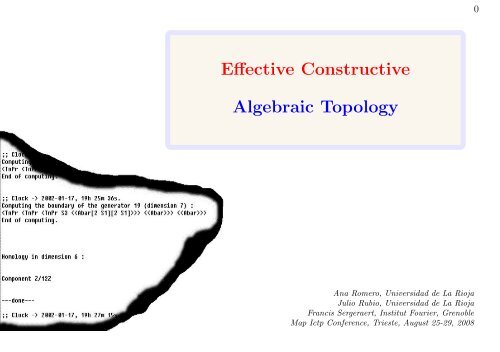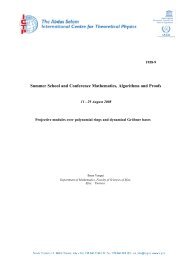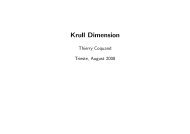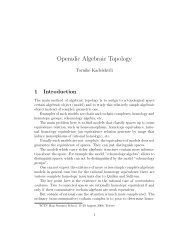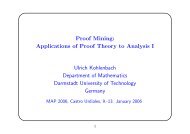Effective Constructive Algebraic Topology - Institut Fourier
Effective Constructive Algebraic Topology - Institut Fourier
Effective Constructive Algebraic Topology - Institut Fourier
Create successful ePaper yourself
Turn your PDF publications into a flip-book with our unique Google optimized e-Paper software.
<strong>Effective</strong> <strong>Constructive</strong><br />
<strong>Algebraic</strong> <strong>Topology</strong><br />
Ana Romero, Universidad de La Rioja<br />
Julio Rubio, Universidad de La Rioja<br />
Francis Sergeraert, <strong>Institut</strong> <strong>Fourier</strong>, Grenoble<br />
Map Ictp Conference, Trieste, August 25-29, 2008<br />
0
Semantics of colours:<br />
Blue = “Standard” Mathematics<br />
Red = <strong>Constructive</strong>, effective,<br />
algorithm, machine object, . . .<br />
Violet = Problem, difficulty, obstacle, disadvantage, . . .<br />
Green = Solution, essential point, mathematicians, . . .<br />
0
Three solutions for <strong>Constructive</strong> <strong>Algebraic</strong> <strong>Topology</strong>:<br />
1. Rolf Schön (Inductive methods).<br />
2. <strong>Effective</strong> Homology.<br />
3. Operadic <strong>Algebraic</strong> <strong>Topology</strong>.<br />
Only the second one so far<br />
Plan of the talk: 1. Computer illustration<br />
led to concrete computer programs.<br />
2. <strong>Constructive</strong> statement of<br />
around CW-complexes.<br />
the homological problem.<br />
3. Other computer illustrations.<br />
1
Attaching a cell D n to a topological space X<br />
X = Topological space.<br />
f : S n−1 → X = continuous map.<br />
along the boundary S n−1 :<br />
⇒ X∪fD n := (X D n )/(X ∋ f(x) ∼ x ∈ S n−1 ).<br />
X<br />
X ∪f D 1<br />
f<br />
f<br />
• •<br />
S 0<br />
• •<br />
D 1<br />
X<br />
X ∪f D 2<br />
f<br />
f<br />
S 1<br />
D 2<br />
2
Notion of CW-Complex X:<br />
X = lim<br />
−→ {X0 ⊂ X1 ⊂ X2 ⊂ X3 ⊂ · · · ⊂ Xn ⊂ · · ·}n∈N<br />
with X0 = discrete space and<br />
the n-skeleton Xn is obtained<br />
from the (n − 1)-skeleton Xn−1<br />
by attaching n-disks Dn 1 , Dn 2 , · · · to Xn−1<br />
according to attaching maps f n 1 , f n 2 , · · ·<br />
Every reasonable space can be presented<br />
up to homotopy equivalence<br />
as a CW-complex of finite type.<br />
3
Example 1. Presentation of X = P 2 R as a CW-complex.<br />
D1 0 f 1<br />
⊃ S → ∗<br />
X0 = ∗<br />
⇒ X1 = X0 ∪ f 1 D 1 = X1 = S 1 = {Z ∈ C st |z| = 1}<br />
D2 1 f 2<br />
⊃ S → S1 : z ↦→ z2 P 2 R =<br />
×<br />
b<br />
⇒ X = X2 = X1 ∪ f 2 D 2 = P 2 R<br />
a ′ b ′<br />
× ×<br />
∗ ∗<br />
×<br />
a<br />
a ∼ a ′<br />
b ∼ b ′<br />
4
Example 2. More generally:<br />
1. X0 = P 0 R = S 0 /∼ = ∗.<br />
Presentation of X = P ∞ R as a CW-complex.<br />
2. Let us assume Xn = P n R constructed.<br />
3. Dn+1 n f n+1<br />
⊃ S −→ P nR 4. ⇒ Xn+1 = D n+1 ∪ f n+1 Xn = P n+1 R.<br />
(++ n) ; goto 2.<br />
5. X = lim→ Xn = P ∞ R.<br />
with f n+1 = the canonical projection.<br />
5
Example 3. Simplicial complexes and simplicial sets.<br />
X = simplicial set.<br />
Definition: The n-skeleton Xn of X is obtained from X by<br />
keeping the non-degenerate simplices of dimen-<br />
sion ≤ n (and their degeneracies), throwing away<br />
the non-degenerate simplices of dimension > n<br />
(and their degeneracies).<br />
|Xn| obtained from |Xn−1|<br />
by attaching n-simplices = n-disks.<br />
⇒ X = CW-complex with |X| = lim→ |Xn|.<br />
6
Simplicial version of P ∞ R:<br />
P ∞ R = X = K(Z2, 1)<br />
⇒ X ND<br />
n<br />
= {σn}<br />
⇒ C∗X = {· · · ←− 0<br />
Z 0<br />
∂iσn = σn−1 if i = 0, n;<br />
= ηi−1σn−2 if 0 < i < n.<br />
←− 1<br />
Z ×2<br />
←− 2<br />
Z 0<br />
←− 3<br />
Z ×2<br />
←− 4<br />
Z 0<br />
←− 5<br />
Z ×2<br />
⇒ Hi(P ∞ R) = Z if i = 0;<br />
Z2 if i > 0 odd;<br />
0 if i > 0 even.<br />
←− · · ·}<br />
7
The same for P ∞ C ?<br />
Topological version ? Easy.<br />
P ∞ C = X = lim→ X2n where:<br />
X2n = X2n−2 ∪ f 2n D 2n<br />
with: D 2n ⊃ S 2n−1 → P n−1 C the canonical projection.<br />
Simplicial version?<br />
Much harder!<br />
8
Easy up to homotopy.<br />
Easiest solution = K(Z, 2).<br />
Justification = two principal fibrations:<br />
S 1 ↩→ S ∞ −→ P ∞ C<br />
K(Z, 1) ↩→ E(Z, 1) −→ K(Z, 2)<br />
+ (K(Z, 1) ∼ S 1 )+(S ∞ contractible) +(E(Z, 1) contractible)<br />
⇒ P ∞ C ∼ K(Z, 2)<br />
Remark: K(Z, 2) not of finite type!<br />
Simplicial model of finite type for P 2 C??<br />
9
Cellular homology.<br />
S n = S 1 × D n−1 / ∼ with (z, x) ∼ (z ′ , x ′ ) if x = x ′ ∈ ∂D n−1 .<br />
D 1 = I<br />
S 1 × 1<br />
S 1 × 0<br />
S 1<br />
∗ × I<br />
• ∗<br />
↦−→<br />
Canonical self-map of degree k for S n :<br />
Theorem (Hopf): C(S n , S n )/∼ ∼ = Z.<br />
•<br />
•<br />
αk : S n → S n : (z, x) ↦→ (z n , x).<br />
•<br />
10
CW-complex:<br />
X = lim Xn = {(D<br />
→ n n<br />
i , fi : S n−1 → Xn−1)1≤i≤mn }n∈N<br />
Associated cellular chain complex:<br />
(mn−1) dn (mn)<br />
· · · ←− Z ←− Z ←− · · ·<br />
Coefficient α1,1 of dn in column 1 and row 1<br />
⇒ g n<br />
1,1 : Sn−1 → Y n−1<br />
1<br />
f n<br />
1 : Sn−1 → X n−1<br />
obtained from g n 1,1 :<br />
= Xn−1 /[X n−2 ∪ (∪i=1D n−1<br />
i )] = S n−1<br />
⇒ α1,1 = deg(g n 1,1 ).<br />
11
Example: X =<br />
X1<br />
X0<br />
D 1 1<br />
• D2 f 1<br />
2 1<br />
D 1 2<br />
Cellular complex = {0 ←− Z d1 2 d2<br />
←− Z ←− Z ←− 0}<br />
with d1 = [0 0] and d2 =<br />
2<br />
2<br />
<br />
⇒ H∗ = {Z, Z2 + Z, 0}<br />
12
Theorem (Adams, 1956): Let X be a 1-reduced CW-complex<br />
Examples:<br />
P 2 C = (∗, 0, 1, 0, 1) ⇒<br />
(one vertex, no 1-cell).<br />
Then ∃ a CW-model for the loop space ΩX,<br />
where every sequence (σ1, . . . , σk) of cells of X<br />
of respective dimensions (d1, . . . , dk) generate<br />
a cell of dimension (d1 + · · · + dk − k) in the<br />
CW-model of ΩX.<br />
S 3 = (∗, 0, 0, 1) ⇒ ΩS 3 = (∗, 0, 1, 0, 1, 0, 1, . . .).<br />
ΩP 2 C = (∗, 1, 1, 2, 3, 4, 6, 9, 13, 19, 28, . . .).<br />
13
Typical example<br />
extracted from<br />
the encyclopedy:<br />
(Ioan James editor).<br />
14
Chapter 13<br />
Stable Homotopy<br />
and Iterated Loop Spaces<br />
Gunnar Carlsson<br />
James Milgram<br />
15
Translation: No known algorithm using these methods<br />
computes H∗(Ω n X) for n ≥ 3<br />
except when X is an n-suspension X = Σ n Y .<br />
Typical example: H∗(Ω 3 (P ∞ R/P 3 R)) = ???<br />
Adams: There exists a finite-type CW-complex<br />
with the homotopy type of Ω 3 (P ∞ R/P 3 R).<br />
Dimension 0 1 2 3 4 5 6 7 8 9 10 · · ·<br />
Cell-# 1 1 2 5 13 33 84 214 545 1388 3535 · · ·<br />
But what about the homological boundary matrices ???<br />
17
Kenzo computing d5 : [C5(Ω 3 ) = Z 33 ] → [C4(Ω 3 ) = Z 13 ] :<br />
========== MATRIX 13 lines + 33 columns =====<br />
L1=[C1=-2]<br />
L2=[C1=-1]<br />
L3=[C1=-4][C2=1][C3=-1][C4=-2]<br />
L4=[C2=1][C3=-1][C6=2]<br />
L5=[C1=6][C4=1][C6=1]<br />
L6=[C1=4][C4=4][C6=4][C7=3]<br />
L7=[C1=4][C12=-2][C14=2]<br />
L8=[C1=6][C4=1][C6=1]<br />
L9=[C1=4][C4=4][C6=4][C7=3]<br />
L10=[C8=4][C10=1][C11=-1][C14=-4][C15=-2][C20=-2]<br />
L11=[C1=4][C8=4][C10=1][C11=-1][C16=-4][C18=-1][C19=1][C23=-2]<br />
L12=[C12=4][C13=2][C16=-4][C18=-1][C19=1][C27=-2]<br />
L13=[C1=-1][C20=4][C21=2][C23=-4][C24=-2][C27=4][C28=2]<br />
========== END-MATRIX<br />
18
Meaning:<br />
∂D 5 1 = S4 1<br />
X4<br />
X3<br />
D 5 1<br />
-2 -1 -4<br />
-1<br />
4<br />
6<br />
6<br />
4<br />
4<br />
D 4 1 D 4 2 D 4 3 · · ·<br />
· · ·<br />
19
Analysis of the problem:<br />
“Standard” homological algebra is not constructive .<br />
Typical statement:<br />
Common translation:<br />
The sequence A α<br />
←− B β<br />
←− C is exact.<br />
(∀b ∈ B) [(α(b) = 0) ⇒ ( ∃c ∈ C st b = β(c))]<br />
with ∃c ∈ C most often non-constructive.<br />
20
<strong>Constructive</strong> exactness:<br />
A α<br />
←− B β<br />
←− C constructively exact<br />
if an algorithm ρ : ker α → C is given satisfying:<br />
A B C<br />
0 ker α<br />
⇒ Organizational algebraic problems:<br />
α<br />
β<br />
=<br />
ρ?<br />
pr<br />
0 Z/2Z Z<br />
where ρ cannot be a group homomorphism.<br />
ρ?<br />
21
Definition: A (homological) reduction is a diagram:<br />
with:<br />
ρ: h C∗<br />
C∗<br />
1. C∗ and C∗ = chain complexes.<br />
2. f and g = chain complex morphisms.<br />
3. h = homotopy operator (degree +1).<br />
4. fg = idC∗ and d C h + hd C + gf = id C∗ .<br />
5. fh = 0, hg = 0 and hh = 0.<br />
g<br />
f<br />
22
Let ρ: h C∗<br />
C∗ be a reduction.<br />
Frequently:<br />
g<br />
f<br />
1. C∗ is a locally effective chain complex:<br />
2. C∗ is an effective chain complex:<br />
its homology groups are unreachable.<br />
its homology groups are computable.<br />
3. The reduction ρ is an entire description of<br />
the homological nature of C∗.<br />
4. Any homological problem in C∗ is solvable<br />
thanks to the information provided by ρ.<br />
23
ρ: h C∗<br />
C∗<br />
g<br />
f<br />
1. What is Hn( C∗)? Solution: Compute Hn(C∗).<br />
2. Let x ∈ Cn. Is x a cycle? Solution: Compute d C∗ (x).<br />
3. Let x, x ′ ∈ Cn be cycles. Are they homologous?<br />
Solution: Look whether f(x) and f(x ′ ) are homologous.<br />
4. Let x, x ′ ∈ Cn be homologous cycles.<br />
Solution:<br />
Find y ∈ Cn+1 satisfying dy = x − x ′ ?<br />
(a) Find z ∈ Cn+1 satisfying dz = f(x) − f(x ′ ).<br />
(b) y = g(z) + h(x − x ′ ).<br />
24
The END<br />
Ana Romero, Universidad de La Rioja<br />
Julio Rubio, Universidad de La Rioja<br />
Francis Sergeraert, <strong>Institut</strong> <strong>Fourier</strong><br />
Map Ictp Conference, Trieste, August 25-29, 2008<br />
0


